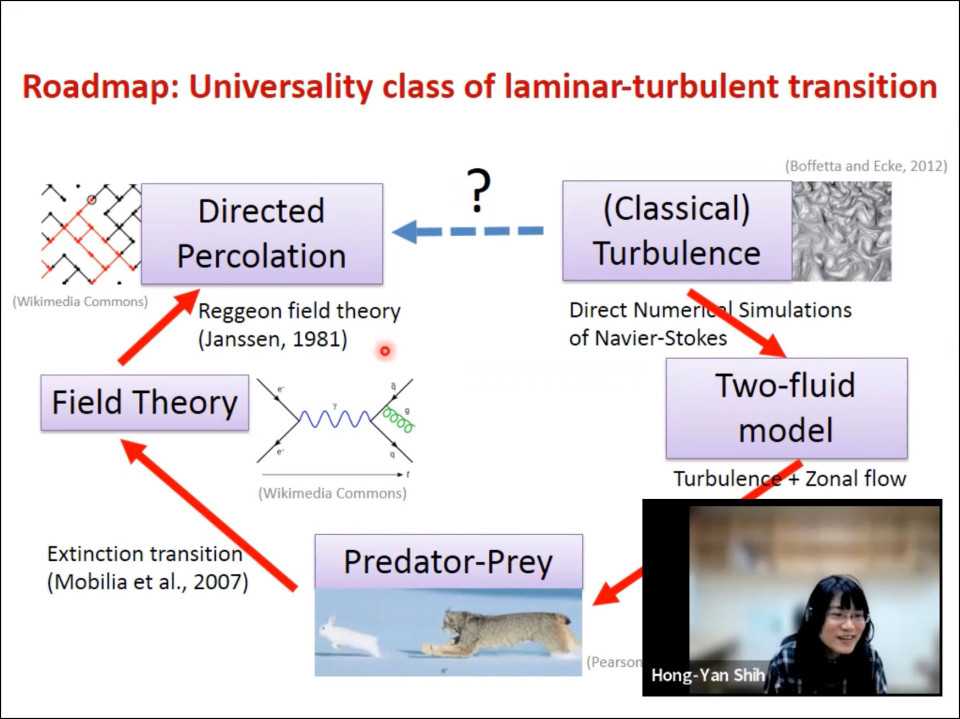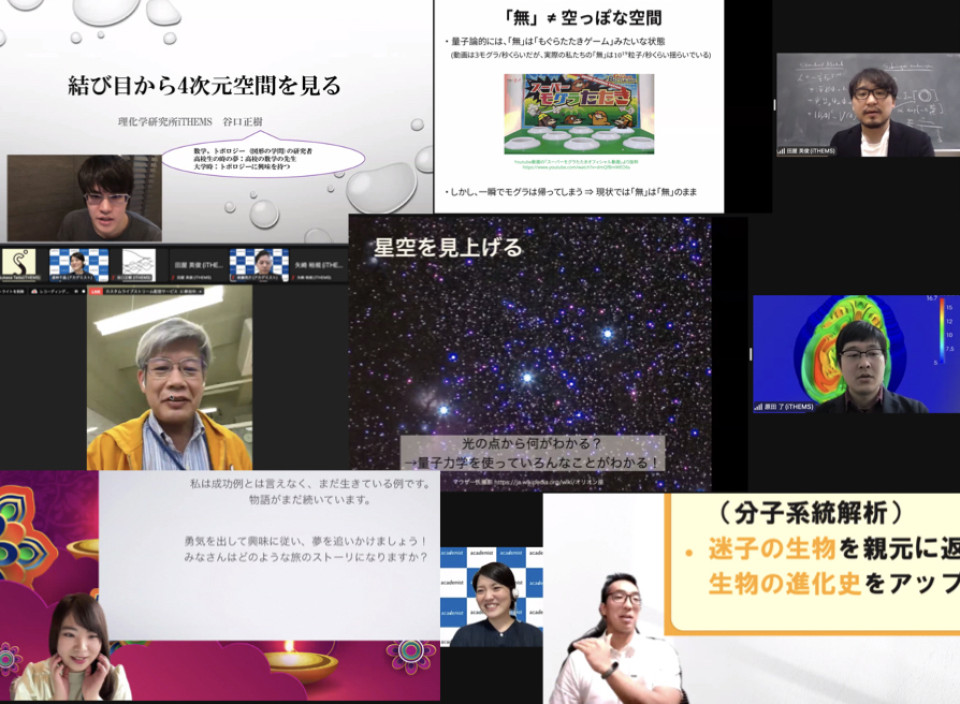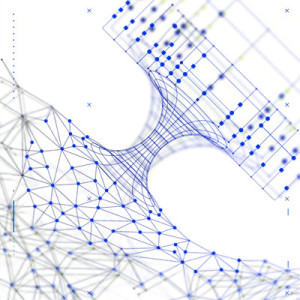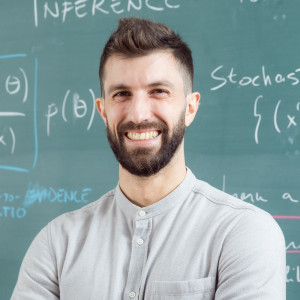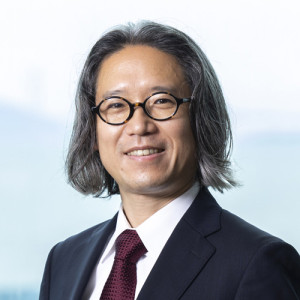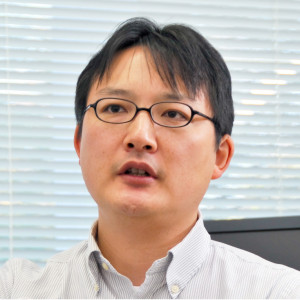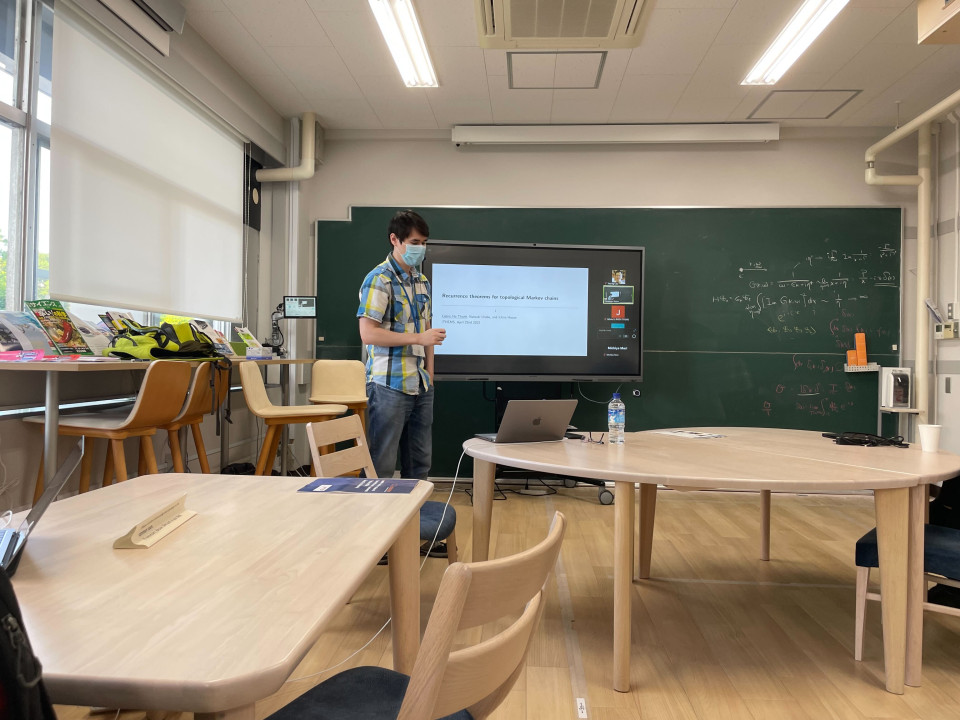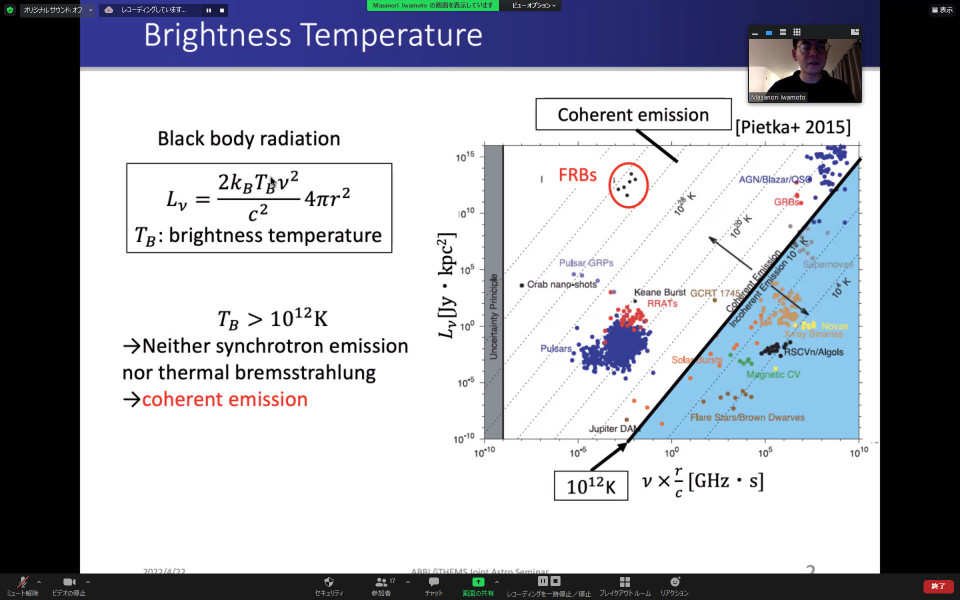Volume 196
Back to Newsletter List
Seminar Report
iTHEMS Colloquium by Dr. Hong-Yan Shih on April 22, 2022
2022-04-28
On April 22 (Fri), we had the first iTHEMS colloquium of FY2022 by inviting Hong-Yan Shih from Academia Sinica, Taiwan. After reviewing the turbulent phenomena in various area of science, she discussed how the turbulence occurs by increasing the flow velocity and how one can develop an effective theory to describe the critical region of laminar-turbulent transition. Then she discussed a remarkable mathematical relation between the effective theory with the predator-prey dynamics in ecology and showed a characteristic super exponential scaling law. The topic was an ideal subject for the interdisciplinary talk, and there were many questions from the researchers with different scientific backgrounds.
How is turbulence born: Statistical mechanics and ecological collapse in transitional fluids
April 22 (Fri) 15:00 - 16:30, 2022
Hot Topic
iTHEMS x academist online event was held on April 24, 2022
2022-04-25
As the alternative for the lectures at RIKEN’s annual open house, iTHEMS held another online lecture event for the general public with the help of Academist Inc., on April 24th, 2022.
This year, the lectures were Masaki Taniguchi, Hidetoshi Taya, Akira Harada, Yingying and Euki Yazaki, who all gave splendid public lectures accessible even to junior-high school students. Each lecturer also served as a commentator to another lecture, asking questions on behalf of the audience.
During the lunch break, Program Director Hatsuda showed the offices of iTHEMS and around. The event was moderated by Ms. Michibayashi from Academist; Her facilitation with a wit kept the event lively. At one time during the event, more than two hundred audiences participated.
iTHEMS x academist Online Event "World of Mathematical Sciences 2022"
April 24 (Sun) 10:00 - 16:30, 2022
Research News
RIKEN Research: Quantum computing and deep learning could help solve the mysteries of quantum gravity
2022-04-25
RIKEN physicists have put quantum computing and deep learning through their paces and found that they are powerful tools for gleaning insights into new theories of quantum gravity [1]. They could thus help solve one of the most formidable challenges in modern physics—developing a theory of gravity that jives with quantum physics.
When Einstein nutted out his theory of general relativity in 1915, his only tools were pen and paper. The same was true of the pioneers of quantum theory. But the next major breakthrough in theoretical physics could be made with help from emerging technologies such as quantum computers and machine learning, Enrico Rinaldi of RIKEN Theoretical Quantum Physics Laboratory thinks. “I believe these technologies are poised to transform the way we do theoretical physics,” he says.
To read more, please visit the related link.
Reference
- Enrico Rinaldi, Xizhi Han, Mohammad Hassan, Yuan Feng, Franco Nori, Michael McGuigan, Masanori Hanada, Matrix-Model Simulations Using Quantum Computing, Deep Learning, and Lattice Monte Carlo, PRX Quantum 3, 010324 (2022), doi: 10.1103/PRXQuantum.3.010324
Award
Takemasa Miyoshi and Yuji Sugita received 2022 MEXT Commendation for Science and Technology
2022-04-28
Takemasa Miyoshi (R-CCS Team Leader/ iTHEMS Deputy Director) received "2022 MEXT Commendation for Science and Technology" for "Study on Big Data Assimilation to Innovate Numerical Weather Forecasting". Congratulations!
Yuji Sugita (CPR Chief Scientist/ iTHEMS Senior Research Scientist) received "2022 MEXT Commendation for Science and Technology" for "Theoretical Study on Dynamic Structure of Biomolecules in the Intracellular Environment". Congratulations!
Seminar Report
Introduction to Topological Insulators by Dr. Tomoki Ozawa on April, 2022
2022-04-28
In this lecture series, Professor Ozawa gave an introduction to topological insulators which are materials whose wavefunctions show nontrivial topological structures in momentum space. In the first two lectures, he introduced the so-called Su-Schrieffer-Heeger model and the bulk-edge correspondence which links edge states with winding number of certain operator in the Hamitonian. Such correspondence has its origin in mathematics called Toeplitz Index theorem which is a special case of Atiyah-Singer index theorem.
In the last two lectures, Chern insulators and quantum metrics are introduced. Eigenvectors of the Hamiltonian define a map from the momentum space (typically a torus) to a complex projective space. The pullback Fubini-Study metric (and standard Kahler form) defines the so-called quantum metric (and Berry curvature) on the momentum space. Using Chern-Weil theory, Chern classes/characters are then defined. Chern classes which are originally notions from differential geometry/topology play an important role in topological insulators. A necessary and sufficient condition is also given when the above mentioned map is an immersion and realises momentum space as a Kahler submanifold of the projective space.
Reported by Yalong Cao
Introduction to Topological Insulators: From Quantum to Classical Physics 1
April 7 (Thu) 15:00 - 17:00, 2022
Seminar Report
iTHEMS Math Seminar by Dr. Cédric Ho Thanh on April 22, 2022
2022-04-25
On April 22, there was a math seminar by Dr. Cédric Ho Thanh. In the first half, he explained the recurrence theorems for the topological Markov chain. In the second half, he explained the sketch of the proof.
Reported by Keita Mikami
Recurrence theorems for topological Markov chains
April 22 (Fri) 17:00 - 19:00, 2022
Seminar Report
ABBL-iTHEMS Joint Astro Seminar by Dr. Masanori Iwamoto on April 22, 2022
2022-04-25
Dr. Masahiro Iwamoto gave a presentation on his recent three-dimensional (3D) particle-in-cell (PIC) simulation of relativistic shocks and application of the results of the 3D-PIC simulations to astrophysical phenomena. For example, the origin of fast radio bursts (FRBs; Lorimer et al. 2007) is one of the unsolved problems in astrophysics. Many observations of FRBs indicate that FRBs must be coherent emission in the sense that coherently moving electrons radiate electromagnetic waves. In relativistic shocks, it is well known that coherent electromagnetic waves are excited by synchrotron maser instability (SMI) in the shock transition (Hoshino & Arons 1991). The SMI is also known as the emission mechanism of coherent radio sources such as auroral kilometric radiation at Earth and Jovian decametric radiation. Recently, some models of fast radio burst based on the coherent emission from relativistic shock via the SMI have been proposed (e.g., Lyubarsky 2014; Beloborodov 2017; Plotnikov & Sironi 2019; Metzger et al. 2019) and the SMI in the context of relativistic shocks attracts more attention from astrophysics. In this seminar, by performing the world’s first 3D-PIC simulation of relativistic shocks, he demonstrated that large-amplitude electromagnetic waves are indeed excited by the SMI even in 3D and that the wave amplitude is significantly amplified and comparable to that in pair plasmas due to a positive feedback process associated with ion-electron coupling. Based on the simulation results, he discussed the applicability of the SMI for FRBs.
Reported by Shigehiro Nagataki
Coherent emission from 3D relativistic shocks
April 22 (Fri) 14:00 - 15:00, 2022
Upcoming Events
Seminar
Quantum Matter Seminar
Introduction to Topological Insulators: Topological Superconductors and Quantum Computing
May 9 (Mon) 14:00 - 15:30, 2022
Ching-Kai Chiu (Senior Research Scientist, RIKEN Interdisciplinary Theoretical and Mathematical Sciences Program (iTHEMS))
References
- A Yu Kitaev, Unpaired Majorana fermions in quantum wires, Phys.-Usp. 44 131 (2001), doi: 10.1070/1063-7869/44/10S/S29
- D. A. Ivanov, Non-Abelian Statistics of Half-Quantum Vortices in p -Wave Superconductors, Phys. Rev. Lett. 86, 268 (2001), doi: 10.1103/PhysRevLett.86.268
Venue: via Zoom
Event Official Language: English
Seminar
Quantum Matter Seminar
Introduction to Topological Insulators: The Ten-fold Classification of Topological Insulators and Superconductors Part.1
May 24 (Tue) 14:00 - 15:30, 2022
Ching-Kai Chiu (Senior Research Scientist, RIKEN Interdisciplinary Theoretical and Mathematical Sciences Program (iTHEMS))
References
- Andreas P. Schnyder, Shinsei Ryu, Akira Furusaki, and Andreas W. W. Ludwig, Classification of topological insulators and superconductors in three spatial dimensions, Phys. Rev. B 78, 195125 (2008), doi: 10.1103/PhysRevB.78.195125
- Alexei Kitaev, Periodic table for topological insulators and superconductors, AIP Conference Proceedings 1134, 22 (2009), doi: 10.1063/1.3149495
Venue: via Zoom
Event Official Language: English
Seminar
NEW WG Seminar
Equilibrium or not? Mathematical differences between acute & chronic virus infections
May 25 (Wed) 13:30 - 15:00, 2022
Catherine Beauchemin (Deputy Program Director, RIKEN Interdisciplinary Theoretical and Mathematical Sciences Program (iTHEMS))
The widely acclaimed 1995/1996 papers by Ho, Perelson and others [1,2] demonstrated the important insights that come from mathematical modelling of virus infection kinetics within a person. But there are key dynamical differences between chronic and acute infections, namely whether the infection reaches or maintains some equilibrium or not. In this talk, I will introduce the equations used to describe a virus infection within a person. I will show some of the tricks used by mathematical modellers to extract important rate estimates from measurements in patients infected with chronic diseases, like HIV or Hepatitis C virus. I will explain why it is difficult to extract meaningful information from measurements in patients with an acute infection, like influenza or possibly COVID-19 [3]. I hope to hear from the audience if they have any thoughts about overcoming the issue to extract better rate information from limited data in patients with acute infections.
(This seminar is a joint seminar between Nonequilibrium working group and Biology study group)
References
- Ho DD, Neumann AU, Perelson AS, Chen W, Leonard JM, Markowitz M., Rapid turnover of plasma virions and CD4 lymphocytes in HIV-1 infection, Nature 373 (6510) 123-6 (1995), doi: 10.1038/373123a0
- Perelson AS, Neumann AU, Markowitz M, Leonard JM, Ho DD, HIV-1 dynamics in vivo: virion clearance rate, infected cell life-span, and viral generation time, Science (1996), doi: 10.1126/science.271.5255.1582
- Palmer J, Dobrovolny HM, and Beauchemin CAA, The in vivo efficacy of neuraminidase inhibitors cannot be determined from the decay rates of influenza viral titers observed in treated patients, Sci. Rep., 7:40210 (2017), doi: doi:10.1038/srep40210
Venue: via Zoom
Event Official Language: English
Seminar
NEW WG Seminar
Superconducting-like heat current: Effective cancellation of current-dissipation trade-off by quantum coherence
July 25 (Mon) 13:30 - 15:00, 2022
Tajima Hiroyasu (Assistant Professor, Graduate School of Informatics and Engineering, The University of Electro-Communications)
Recent developments in statistical mechanics have revealed a tradeoff between heat current and dissipation [1,2]. In various situations, this current-dissipation tradeoff represents a relationship between thermal energy flow and entropy increase, similar to Joule’s law W=RI^2.
On the other hand, the coherence effect on the current-dissipation tradeoff has not been thoroughly analyzed. Here, we systematically analyze how coherence affects the current-dissipation tradeoff [3]. The results can be summarized in the following three rules:
- Quantum coherence between different energy levels strengthens the trade-off. In other words, the ratio between the square of the heat current and the entropy production ratio corresponding to electrical resistance R (hereafter referred to as "thermal resistance") is increased by the superposition of different energy levels.
- Coherence between degeneracies weakens the trade-off. That is, thermal resistance is weakened by coherence between degeneracies.
- With enough coherence between degeneracies, we can cancel the trade-off effectively and make the thermal resistance approximately zero. Then, macroscopic heat flow without entropy increase is realized.
These three results directly reveal the coherence effects on heat engine performance. That is, coherence between different energy levels reduces the performance, while coherence between degeneracies increases it. And when there is a sufficient amount of coherence between degeneracies, the efficiency can asymptotically reach the Carnot efficiency (η=η_{Car}-O(1/N)) while the power is O(N).
References
- N. Shiraishi, K. Saito, H. Tasaki, Universal Trade-Off Relation between Power and Efficiency for Heat Engines, Phys. Rev. Lett. 117, 190601 (2016), doi: 10.1103/PhysRevLett.117.190601
- A. C. Barato, U. Seifert, Thermodynamic Uncertainty Relation for Biomolecular Processes, Phys. Rev. Lett. 114, 158101 (2015), doi: 10.1103/PhysRevLett.114.158101
- H. Tajima, K. Funo, Superconducting-like Heat Current: Effective Cancellation of Current-Dissipation Trade-Off by Quantum Coherence, Phys. Rev. Lett. 127, 190604 (2021), doi: 10.1103/PhysRevLett.127.190604
Venue: via Zoom
Event Official Language: English
Paper of the Week
Week 5, April 2022
2022-04-28
Title: Visualizing Lamb Waves From a Volcanic Eruption Using Meteorological Satellite Himawari-8
Author: Shigenori Otsuka
Journal Reference: Geophysical Research Letters, 49, e2022GL098324 (2022)
doi: https://doi.org/10.1029/2022GL098324
If you would like to cancel your subscription or change your email address,
please let us know via our contact form.
Copyright © iTHEMS, RIKEN. All rights reserved.


